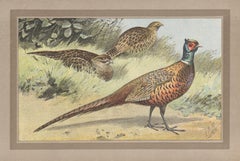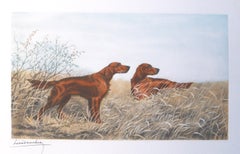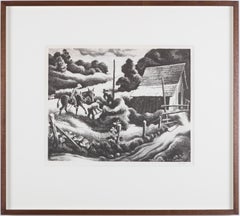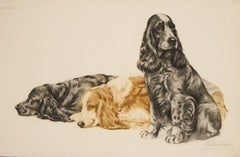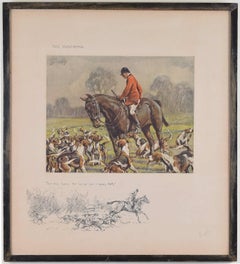1930s Animal Prints
to
18
133
12
7
5
2
Overall Width
to
Overall Height
to
80
27
9
4
1
1
32
8
5
3
3
710
1,434
2,625
1,840
31
29
67
160
102
136
246
605
363
332
678
125
33
67
49
42
40
33
26
20
18
14
13
11
11
9
5
5
4
4
4
4
3
114
23
12
11
6
11
2
65
19
Period: 1930s
Pheasant, French antique natural history bird art illustration print
Located in Melbourne, Victoria
French chromolithograph, published in 1931. Printed title lower right of sheet. Plate number top right. From a French series of illustrations of birds.
195mm by 265mm (sheet)
Category
Art Deco 1930s Animal Prints
Materials
Lithograph
Irish Setters in the Field original etching by Leon Danchin
By Leon Danchin
Located in Paonia, CO
Irish Setters in the Field is an original etching by Leon Danchin showing two adult Irish Setters in a field pointing to the right.This etching is printed on Arches paper, pencil si...
Category
Other Art Style 1930s Animal Prints
Materials
Etching
Haystack
Located in London, GB
A fine impression of this very popular image with full margins (smaller on top and bottom) published by Associated American Artists.
Category
American Modern 1930s Animal Prints
Materials
Lithograph
Three Cocker Spaniels original signed etching by Leon Danchin
By Leon Danchin
Located in Paonia, CO
Three Cocker Spaniels is an original color etching by well known French sports artist Leon Danchin. The three Spaniels are in waiting mode with two lying down and one sitting ...
Category
Realist 1930s Animal Prints
Materials
Etching
Snaffles: 'The Huntsman' signed lithograph - "The 'oss loves the 'ound"
Located in London, GB
To see our other hunting prints and paintings, scroll down to "More from this Seller" and below it click on "See all from this Seller" and then search.
C...
Category
Impressionist 1930s Animal Prints
Materials
Lithograph
Snaffles: 'The Timber Merchant' 1930s lithograph signed in pencil
Located in London, GB
To see our other hunting prints and paintings, scroll down to "More from this Seller" and below it click on "See all from this Seller" and then search.
Charles "Snaffles" Johnson Payne (1884-1967)
The Timber Merchant (c. 1932)
Lithograph
47 x 43 cm
Signed in pencil...
Category
Impressionist 1930s Animal Prints
Materials
Lithograph
Jon Corbino, Montana Earthquake, 1936, lithograph
By Jon Corbino
Located in New York, NY
Works by Jon Corbino (1905-1964) feature drama. Here he's showing us the chaos produced by a major earthquake in rural Montana in 1936 -- an actual historical event.
The horses (ear...
Category
American Modern 1930s Animal Prints
Materials
Lithograph
Bassets D'Artois a Jambes Droites, French hound dog chromolithograph print 1930s
By P. Mahler
Located in Melbourne, Victoria
'Bassets D'Artois a Jambes Droites'.
French chromolithograph, published in 1931. Signed by artist in the plate. Printed title lower right of sheet. Plate number top right. From a Fr...
Category
Art Deco 1930s Animal Prints
Materials
Lithograph
French Spaniel, French hound dog chromolithograph print, 1930s
By P. Mahler
Located in Melbourne, Victoria
French chromolithograph, published in 1931. Signed by artist in the plate. Printed title lower right of sheet. Plate number top right. From a French series of illustrations of sporti...
Category
Art Deco 1930s Animal Prints
Materials
Lithograph
Cheetah - From Chats et Autres Bêtes - Lithograph 1933
Located in Roma, IT
Cheetah - From Chats et Autres Bêtes is an original black and white lithograph realized in 1933 by Théophile Alexandre Steinlen.
Signed on plate.
The lithograph, on Arches vellum,...
Category
1930s Animal Prints
Materials
Lithograph
Original Affiches Paul Mohr Compagnie Nationale des Papers 1932 vintage poster
Located in Spokane, WA
Original small format poster Affiches Paul Mohr, 1932. Archival linen backed in excellent condition, ready to frame. The rare Paul Mohr posters are incredibly elusive; many have had only one remaining known copy survive. Printing method: Helio-Typo or Typelo.
Before television, beautiful lithographs adorn the streets and walls of Paris and other European cities. Art for the street, art for the public. Weather and rain would destroy these works of art by renowned artists, only to be replaced.
The artist: Paul Gustave Mohr, a French Avant-garde poster designer from the Art Deco period was born Sept. 4, 1890 in Ham, France and died on April 13, 1959 in Paris. He lived most of his life in Paris, and then settled in the small town of Asnieres, France, just outside of Paris. He attended the Sorbonne University, as well as several art schools. During World War I, he was a pilot in the French Army from 1914-1917. Paul Mohr married Jeanne Levy in 1917 and they had three daughters: Helene, Genevieve, and Jacqueline.
As an artist, he designed advertising posters from 1920 to 1940. His
posters advertised Wonder cycles, Dainty cycles, Lustucru pasta, Banania sugar, Bremsit brakes, Champigneulles beer, L'Union beer, Dubonnet wine, as well as shoes and ham.
This information was provided to me by my mother, Helene Mohr Breitenbucher, who was his eldest daughter. Carol Schuler (granddaughter)
Advertising posters, the affiches of Paul Mohr. This is an original advertising poster for the affiches (posters) created by the master artist Paul Mohr (1890-1959). Archival linen backed in very good condition. No stains, no tears, no paper loss. Grade A condition. Ready to frame. Compagnie Nationale des Papier, Paris.
The crowd on the street looks up in amazement at the art deco-style images that the artist created. Images on the wall feature incredible image that this artist created such as Lustucru, Amer...
Category
Art Deco 1930s Animal Prints
Materials
Offset
Pointer, French hound dog chromolithograph print, 1930s
By P. Mahler
Located in Melbourne, Victoria
French chromolithograph, published in 1931. Signed by artist in the plate. Printed title lower right of sheet. Plate number top right. From a French series of illustrations of sporti...
Category
Art Deco 1930s Animal Prints
Materials
Lithograph
TAUREAU AILE CONTEMPLE PAR QUATRE ENFANTS (BLOCH 229)
Located in Aventura, FL
Plate 13 from La Suite Vollard. Bloch 229. Baer 444. Etching on Montval paper. Signed in pencil, from the edition of 260 (there was also an edition of 50 with larger margins). Printe...
Category
Cubist 1930s Animal Prints
Materials
Paper, Engraving
$31,600 Sale Price
29% Off
Original Visitez Les Aquariums Mosans vintage poster
Located in Spokane, WA
"Original Vintage Aquariums Mosans Poster – Art Deco Design by A. de Loof, 1930s European Travel Advertising"
Discover the Captivating "Moselle Aquariums" - A Vintage Poster by A. d...
Category
Art Deco 1930s Animal Prints
Materials
Lithograph
Persian Greyhound, French hound dog chromolithograph print, 1931
By P. Mahler
Located in Melbourne, Victoria
French chromolithograph, published in 1931. Signed by artist in the plate. Printed title lower right of sheet. Plate number top right. From a French series of illustrations of sporti...
Category
Art Deco 1930s Animal Prints
Materials
Lithograph
A La Queue (Join the Queue) Naughty Dogs of Paris by O'Klein
Located in Paonia, CO
A La Queue (Join the Queue) original etching from the series Naughty Dogs of Paris showing a line of five dogs of various breeds trailing a small Chihuahua on a leash who is turning her head towards the queue. This original etching is in excellent condition, hand signed by the artist and published by Sidney Lucas.
paper size 13.75 x 29.25 image size 8.50 x 24
Boris O'Klein ( 1893-1985 ) immigrated to France from Russia with his family when he was a young boy. He settled in Paris after World War I and became a prolific artist well known for his watercolors and etchings of dogs getting into mischief. His images are often risque and are considered very humorous. They have been referred to as the Naughty or Dirty Dogs of Paris.
Category
Other Art Style 1930s Animal Prints
Materials
Etching
Brittany Spaniel, French hound dog chromolithograph print, 1931
Located in Melbourne, Victoria
French chromolithograph, published in 1931. Signed by artist in the plate. Printed title lower right of sheet. Plate number top right. From a French series of illustrations of sporti...
Category
Art Deco 1930s Animal Prints
Materials
Lithograph
Black Spaniel , French hound, dog chromolithograph, 1930s
By P. Mahler
Located in Melbourne, Victoria
French chromolithograph, published in 1931. Signed by artist in the plate. Printed title lower right of sheet. Plate number top right. From a French series of illustrations of sporti...
Category
Art Deco 1930s Animal Prints
Materials
Lithograph
Plate 20 from "Formes et Couleurs"
Located in New York, NY
Plate 20 from "Formes et couleurs; vingt planches en couleurs contenant soixante-sept motifs décoratifs" by Auguste H. Thomas. Paris: A. Levy, Librarie Centrale des Beaux-Arts, circa...
Category
1930s Animal Prints
Materials
Paper
Original "Queen of the Jungle" US 1-sheet vintage (1935) movie poster
Located in Spokane, WA
Original Queen of the Jungle vintage lithograph movie poster, archival linen backed. US 1-sheet.
"The Temple of Mu." Serial. Episode No 10. St...
Category
American Modern 1930s Animal Prints
Materials
Lithograph
$760 Sale Price
20% Off
Basset Bleu de Gascogne, French hound dog chromolithograph print, 1930s
By P. Mahler
Located in Melbourne, Victoria
'Basset Bleu de Gascogne'.
French chromolithograph, published in 1931. Signed by artist in the plate. Printed title lower right of sheet. Plate number top right. From a French serie...
Category
Art Deco 1930s Animal Prints
Materials
Lithograph
The Last Fence Maryland Hunt Cup 1932 Proof Plate
Located in Bristol, CT
Print Sz: 9 1/2"H x 12 1/2"W
1933
Proof Plate for 'Spills and Thrills' Published by Charles Scribner's Sons New York 1933
Category
1930s Animal Prints
Materials
Paper, Lithograph
Harrier, French hound dog chromolithograph print, 1931
Located in Melbourne, Victoria
French chromolithograph, published in 1931. Signed by artist in the plate. Printed title lower right of sheet. Plate number top right. From a French series of illustrations of sporti...
Category
Art Deco 1930s Animal Prints
Materials
Lithograph
Bassets D'Artois a Jambes Torses, French hound dog chromolithograph print 1930s
By P. Mahler
Located in Melbourne, Victoria
'Bassets D'Artois a Jambes Torses'.
French chromolithograph, published in 1931. Signed by artist in the plate. Printed title lower right of sheet. Plate number top right. From a Fre...
Category
Art Deco 1930s Animal Prints
Materials
Lithograph
Ferruginous Duck, French antique bird duck art illustration print
By P. Mahler
Located in Melbourne, Victoria
'Canard Nyroca - Canard Milouinan'
(Ferruginous Duck)
French chromolithograph, published in 1931. Printed title lower right of sheet. Plate number top right. From a French series o...
Category
Art Deco 1930s Animal Prints
Materials
Lithograph
Pont-Audemer Spaniel, French hound dog chromolithograph print, 1930s
By P. Mahler
Located in Melbourne, Victoria
French chromolithograph, published in 1931. Signed by artist in the plate. Printed title lower right of sheet. Plate number top right. From a French series of illustrations of sporti...
Category
Art Deco 1930s Animal Prints
Materials
Lithograph
Original 'Produits Lavocat' vintage poster for Force and Energy
Located in Spokane, WA
Original vintage poster: Lavocat aliments irradies. Force, Energie par les produits. This is a classic French late Art Deco period poster featuring a buff rugby player almost outpacing a steed - due no doubt to Lavocat, an 'irradiated' food. Even today, the American FDA believes that irradiating food can burn off harmful bacteria, airborne germs, and other microbes which can adversely affect food. We love this poster's depth of color, texture, and oomph - powerful and very, very Art Deco. This poster is an original Art Deco lithograph. This poster is related more to sports and running than food, but food provides energy.
Note that the red is cherry red since different monitors produce the red color of this poster in different qualities. Excellent condition, undated on the poster.
Behind the rugby runner is a black horse that appears to be neck and neck...
Category
Art Deco 1930s Animal Prints
Materials
Lithograph
$631 Sale Price
20% Off
Reginald Wilson, Horses
Located in New York, NY
Although this work is titled Horses. It nice to think it could be (Horses in a Field in Woodstock, NY), but it was printed by Will Barnet at the Art Students League, about 1938, and Wilson, who visited Woodstock with Arnold Blanche...
Category
American Modern 1930s Animal Prints
Materials
Lithograph
Tulip Pochoir from Relais
Located in New York, NY
Benedictus, Edouard.
Relais.
Plate 1.
Paris, Éditions Vincent, Fréal et Cie, 1930.
Original pochoir, printed by J. Saudé.
Category
Art Deco 1930s Animal Prints
Materials
Paper
Brunelleschi, Composition, La Leçon d'amour dans un parc (after)
Located in Southampton, NY
Lithograph and stencil on vélin d’Arches paper. Unsigned and unnumbered, as issued. Good condition. Notes: From the volume, La Leçon d'amour dans un parc, 1933. Published by Éditions...
Category
Modern 1930s Animal Prints
Materials
Lithograph, Stencil
$1,436 Sale Price
20% Off
Minna Citron, Heifer
By Minna Citron
Located in New York, NY
This subject, Heifer, relates to Citron's mural project focusing on the Tennessee Valley Authority.
It is signed, dated, and annotated 'Et...
Category
Ashcan School 1930s Animal Prints
Materials
Etching
Wild Boar, French antique natural history animal art print
Located in Melbourne, Victoria
Sanglier (Wild Boar)
French chromolithograph, published in 1931. Printed title lower right of sheet. Plate number top right. From a French series of ill...
Category
Art Deco 1930s Animal Prints
Materials
Lithograph
Big Horse, Black & Moorhead 46 very scarce 1932 engraving + drypoint signed 8/30
Located in New York, NY
Stanley William Hayter
Big Horse (Black & Moorhead 46), 1932
Engraving & Drypoint on antique white Canson Vidalon laid paper affixed to original matting
Hand signed, numbered 8/30 an...
Category
Abstract Expressionist 1930s Animal Prints
Materials
Engraving, Drypoint
The Quorn Hunt, Holy Vale hunting print by Lionel Edwards
Located in London, GB
To see our other hunting pictures, scroll down to "More from this Seller" and below it click on "See all from this Seller" and then search.
Lionel Edwards (1878 - 1966)
The Quorn Hu...
Category
1930s Animal Prints
Materials
Lithograph
Resting The Horses
Located in New York, NY
Etching, 1937. Signed by the artist and dated in pencil lower right margin.
A scarce etching by this important American western artist.
Category
American Realist 1930s Animal Prints
Materials
Etching
Jean Lurcat, S.O.S., from Eight Drawings, 1933 (after)
By Jean Lurçat
Located in Southampton, NY
This exquisite heliogravure after Jean Lurcat (1892–1966), titled S.O.S., from the folio Jean Lurcat Huit Dessins (Jean Lurcat Eight Drawings), originates from the 1933 edition publi...
Category
Surrealist 1930s Animal Prints
Materials
Lithograph
$716 Sale Price
20% Off
2 Lazy 2 P
Located in Phoenix, AZ
2 Lazy 2P, ca. 1939
Lon Megargee
Serigraph
20 x 24 inches
Signed in screen
Original serigraph print by Lon Megargee 1883 - 1960
Featured in "Hot Irons" by Oren Arnold and John Hale, 1940
SHIPPING CHARGES INCLUDE SHIPPING, PACKAGING & INSURANCE
Lon Megargee created this serigraph from his commission with Oren Arnold and John Hale to do their dust jacket for the book, " Hot Irons", 1940. Arnold and Hale wanted to establish a reference work, an "authority", with a entertaining history about the evolution of the brand. Megargee created a painting of a steer that was branded with the script, 2 Lazy 2 P. Surrounding the steer is a random display of famous brands of ranches in the Southwest. It was well received and must have prompted Megargee to create the likeness as a print.
The brand is described in chapter thirteen, page 207-208 and says, " Ed Stram, who was Arizona state veterinarian for sixteen years, fire-branded his cattle with this peculiar crest. It isn't peculiar unless you have an equally peculiar sense of humor. At a glance it appears to be just another typically unimaginative brand, but it has been used to make many a thousand girls blush, and a few thousand bashful young men as well".
COLLIER GALLERY, FINE ART ESTATE OF LON MEGARGEE
Born and raised in Philadelphia, Pennsylvania, Lon Megargee, at age 13, ran away from his upper class home and went West in 1896 led by his zest for the wild and adventuresome life. There he established a reputation as a cowboy painter and illustrator with work most associated with Arizona Brewing Company ads featuring humorous aspects of cowboy life.
In his youth, he worked as a free-lance cowboy, exhibition roper, poker dealer, and bronco buster in Arizona, and then went east again to study art in Philadelphia at the Pennsylvania Academy of Fine Arts, and to New York at the Art Students League and Pratt Institute.
He returned to Arizona, living in Cave Creek, Salt River Canyon, Phoenix and the last years of his life near Sedona. His Phoenix home later became a popular hotel and dining place called the Hermosa Inn.
Megargee was a ranch owner and also did oil canvases of the places he loved and the cowboy life he admired. By 1910, he was among the earliest resident artists, and was probably the best known artist in Arizona. His name was first associated with a landscape series of 15 large murals for the Capitol Building, newly constructed just after Arizona became a state in 1912. Another one of his paintings, Elemental, was the first painting by an artist living in Arizona to be acquired for the Municipal Collection of Phoenix. These works were chosen from entries in the State Fair, where he continued to win prizes for figure and landscape painting.
From 1911 to 1953, he did numerous commission works for the Santa Fe Railroad, including a work titledNavajos Watching a Santa Fe Train. Between 1915 and 1930, he also painted in the Los Angeles area of California and had entries in the California State Fair. He died in Cottonwood, Arizona. After his death, theSaturday Evening Post had a double-page reproduction of his painting Cowboy's Dream.
Creator of the iconic logo for the Stetson Hat Company, " Last Drop From his Stetson", still in use today.
Fine Art Estate of Lon Megargee
We offer signed in print and original signature block prints. Custom, hand carved, signature frames, with archival standards and a speciality in hand dyed mats and french matting are provided for a beautiful and timeless presentation.
Megargee explored different mediums; printmaking captivated him in particular. The contrast of the black and white block print method captured perfectly his interpretation of a bold American West. The first print was produced around 1921 and culminated with the creation of “The Cowboy Builds a Loop” in 1933 with 28 images and poetry by his friend, Roy George. Megargee continued producing prints throughout the 1940s and early 50s.
At age 13, Lon Megargee came to Phoenix in 1896 following the death of his father in Philadelphia. For several years he resided with relatives while working at an uncle’s dairy farm and at odd jobs. He returned to Philadelphia in 1898 – 1899 in order to attend drawing classes at the Pennsylvania Academy of the Fine Arts. Back in Phoenix in 1899, he decided at the age of 16 to try to make his living as a cowboy. Lon moved to the cow country of Wickenburg where he was hired by Tex Singleton’s Bull Ranch. He later joined the Three Bar Ranch . . . and, after a few years, was offered a job by Billy Cook...
Category
American Modern 1930s Animal Prints
Materials
Screen
Leonard Foujita - Woman with Felines - Original Engraving
Located in Collonge Bellerive, Geneve, CH
Artist : Léonard Foujita (Tsuguharu)
Title: Woman with Felines
Engraving
Edition of 315
Dimensions: 38 x 28 cm
From La Rivière enchantée
Unsigned and unumbered as issued
Category
1930s Animal Prints
Materials
Engraving
Original Fontainebleau Avon 1930s vintage French travel poster on linen backing
Located in Spokane, WA
Rare Original "Fontinebleua" Avon – artist Lulien Lacaze – Vintage PLM Railway Poster (Linen Backed).
Add a touch of classic French elegance to your collection with this authentic "...
Category
1930s Animal Prints
Materials
Lithograph
Asie (Asia) from the series Atlas — Atelier 17
By Joseph Hecht
Located in Myrtle Beach, SC
Joseph Hecht, 'Asie (Asia) from the series Atlas', engraving, 1928, edition c. 50, Tonneau-Ryckelynck & Plumart 162. Signed and annotated 'epreuve definitive' (final proof) in pencil...
Category
Modern 1930s Animal Prints
Materials
Engraving
Bassets Ardennais, French hound dog chromolithograph print, 1930s
By P. Mahler
Located in Melbourne, Victoria
'Bassets Ardennais'.
French chromolithograph, published in 1931. Signed by artist in the plate. Printed title lower right of sheet. Plate number top right. From a French series of i...
Category
Art Deco 1930s Animal Prints
Materials
Lithograph
The Charge Of The Light Brigade Maryland Hunt Cup 1930
Located in Bristol, CT
Art Sz: 9 1/2"H x 12 1/2"W
1933
Proof Plate for 'Spills and Thrills' Published by Charles Scribner's Sons New York 1933
Category
1930s Animal Prints
Materials
Paper, Lithograph
Greyhound, French hound dog chromolithograph print, 1930s
By P. Mahler
Located in Melbourne, Victoria
French chromolithograph, published in 1931. Signed by artist in the plate. Printed title lower right of sheet. Plate number top right. From a French series of illustrations of sporti...
Category
Art Deco 1930s Animal Prints
Materials
Lithograph
Cocker Spaniel, French hound dog chromolithograph print, 1931
By P. Mahler
Located in Melbourne, Victoria
French chromolithograph, published in 1931. Signed by artist in the plate. Printed title lower right of sheet. Plate number top right. From a French series of illustrations of sporti...
Category
Art Deco 1930s Animal Prints
Materials
Lithograph
THREE'S A CROWD
Located in Santa Monica, CA
MARGUERITE KIRMSE (English/American 1885-1954)
THREE’S A CROWD, c 1930
Etching, signed and titled in pencil. Plate 6 3/8 x 9 ¾ inches. Full sheet with edges on all sides. Sheet 10 5/8 x 13 5/8 inches. In good condition, save for old tape on sheet edges verso, showing through to recto. A hint of a mat line below the signature
Kirmse is considered to be one of the most important etchers of Dogs.
Sheet with even white tone - photos show oblique shadows
From Wikipedia:
Marguerite first trained as a harpist at the Royal Academy of Music but spent much of her spare time drawing animals. She went to the United States in 1910 on holiday with friends but stayed there.[4] She was not successful in advancing her musical career and focused her attention increasingly on her animal drawing, which she developed by frequent sketching trips to the Bronx Zoo.[5]
In 1921 she started producing etchings of dogs...
Category
American Realist 1930s Animal Prints
Materials
Etching
$506 Sale Price
25% Off
Alexander Calder Circus Reproduction Lithograph After a Drawing
Located in Surfside, FL
(after) Alexander Calder
"Calder's Circus" offset lithograph on wove paper after drawings by the artist
Published by Art in America and Perls gallery in 1964 (from drawings done in t...
Category
American Modern 1930s Animal Prints
Materials
Lithograph
The Lonely Tower
Located in New Orleans, LA
This is a fine aquatint etching by British artist Percival Gaskell. The title is: The Lonely Tower, Roman Campagna, it was created and printed in 1924 in an edition of 150. The ima...
Category
English School 1930s Animal Prints
Materials
Aquatint
$280 Sale Price
20% Off
Squirrel, French antique natural history animal art print
Located in Melbourne, Victoria
Ecurueil (Squirrel)
French chromolithograph, published in 1931. Printed title lower right of sheet. Plate number top right. From a French series of illu...
Category
Art Deco 1930s Animal Prints
Materials
Lithograph
"The Fish" Ida Ten Eyck O'Keeffe, Trout, Black and White, Water, Animal Art
Located in New York, NY
Ida Ten Eyck O'Keeffe
The Fish, 1935
Signed and dated in pencil lower right
Monotype on paper
Image 6 x 8 1/2 inches
Exhibited
Dallas Museum of Art, Ida O'Keeffe: Escaping Georgia's...
Category
American Modern 1930s Animal Prints
Materials
Paper, Monotype
Nightjar, French antique natural history bird art illustration lithograph print
Located in Melbourne, Victoria
French chromolithograph, published in 1931. Printed title lower right of sheet. Plate number top right. From a French series of illustrations of birds.
195mm by 265mm (sheet)
Category
Art Deco 1930s Animal Prints
Materials
Lithograph
A La Queue (Join the Queue) Naughty Dogs of Paris by O'Klein
Located in Paonia, CO
A La Queue (Join the Queue) original etching from the series Naughty Dogs of Paris showing a line of five dogs of various breeds trailing a small Chihuahua on a leash who is t...
Category
Other Art Style 1930s Animal Prints
Materials
Etching
$440 Sale Price
20% Off
Water Rail, French antique natural history water bird art print
Located in Melbourne, Victoria
Rale D'Eau - Water Rail
French chromolithograph, published in 1931. Printed title lower right of sheet. Plate number top right. From a French series of illustrations of birds.
195...
Category
Art Deco 1930s Animal Prints
Materials
Lithograph
Alexander Calder Circus Reproduction Lithograph after a Drawing
Located in Surfside, FL
(after) Alexander Calder
"Calder's Circus" offset lithograph on wove paper reproduction after drawings by the artist
Published by Art in America and Perls gallery in 1964 (from drawi...
Category
American Modern 1930s Animal Prints
Materials
Lithograph
Pekingnese, Chow and Spaniel, Cecil Aldin 1930s puppy dog lithograph
Located in Melbourne, Victoria
'Pekingnese, Chow and Spaniel'
Cecil Aldin dog lithograph, 1935.
Cecil Aldin was a British artist and illustrator best known for his paintings and sketches of animals, sports, and ...
Category
English School 1930s Animal Prints
Materials
Lithograph
Batard Anglo-Normand, French hound, dog chromolithograph, 1930s
By P. Mahler
Located in Melbourne, Victoria
French chromolithograph, published in 1931. Signed by artist in the plate. Printed title lower right of sheet. Plate number top right. From a French series of illustrations of sporti...
Category
Art Deco 1930s Animal Prints
Materials
Lithograph
Chow and Pekinese (Pekingnese), Cecil Aldin 1930s puppy dog lithograph
Located in Melbourne, Victoria
'Chow and Pekinese' (Pekingnese)
Cecil Aldin dog lithograph, 1935.
Cecil Aldin was a British artist and illustrator best known for his paintings and sketches of animals, sports, an...
Category
English School 1930s Animal Prints
Materials
Lithograph
Curly Coated Retriever, French hound dog chromolithograph print, 1930s
By P. Mahler
Located in Melbourne, Victoria
French chromolithograph, published in 1931. Signed by artist in the plate. Printed title lower right of sheet. Plate number top right. From a French series of illustrations of sporti...
Category
Art Deco 1930s Animal Prints
Materials
Lithograph
Otterhound Ou Chien Pour Loutres, French hound, dog chromolithograph, 1930s
By P. Mahler
Located in Melbourne, Victoria
French chromolithograph, published in 1931. Signed by artist in the plate. Printed title lower right of sheet. Plate number top right. From a French series of illustrations of sporti...
Category
Art Deco 1930s Animal Prints
Materials
Lithograph
Irish Setter, French hound dog chromolithograph print, 1930s
By P. Mahler
Located in Melbourne, Victoria
French chromolithograph, published in 1931. Signed by artist in the plate. Printed title lower right of sheet. Plate number top right. From a French series of illustrations of sporti...
Category
Art Deco 1930s Animal Prints
Materials
Lithograph
Alexander Calder Circus Reproduction Lithograph After a Drawing
Located in Surfside, FL
(after) Alexander Calder
"Calder's Circus" offset lithograph on wove paper after drawings by the artist
Published by Art in America and Perls gallery in 1964 (from drawings done in t...
Category
American Modern 1930s Animal Prints
Materials
Lithograph
Recently Viewed
View AllMore Ways To Browse
Penguin Lithograph
Peter Klucik
Pheasant Engraving
Picasso Dove Of Peace
Picasso Le Taureau
Picasso Rooster
Ronald Smith
Rooster Print Picasso
Salvador Dali Argus
Salvador Dali Unicorn
Sam Savitt
Shore Bird Print
Space Elephant Dali
Szabolcs Bozo
The Toad Picasso
Vintage Forest Service Posters
Vintage Posters Coppertone
Warhol Siberian Tiger
